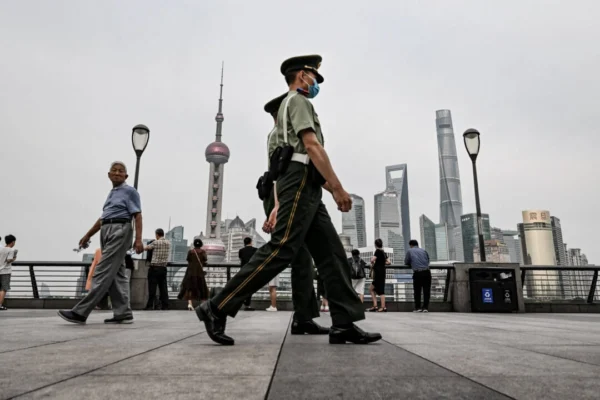As China’s domestic economy declines and trade tensions with the United States and the European Union intensify, not only foreign companies and investors are withdrawing from China, but Chinese companies and investors are also leaving in droves.
In the last quarter, foreign investors withdrew nearly $15 billion from China, hitting a historical high and resulting in a negative net inflow of foreign direct investment. Meanwhile, foreign direct investment in the United States is on the rise.
Despite the People’s Bank of China continuously lowering interest rates to stimulate the domestic economy, investors can simply purchase U.S. government bonds to gain around a 5% return, thus avoiding the risks associated with China’s economic slowdown. It seems unlikely that China’s economy will reach its 5% growth target this year as GDP growth in the second quarter was only 4.7%, below expectations.
Since the end of the COVID-19 lockdowns, China’s struggling economy has yet to recover. Over the past three years, the Chinese stock market has continued to decline, resulting in a market value loss of over $6 trillion. Exports shrank in May, saw a slight recovery in June, and slowed down in July, falling short of expectations by 2.7 percentage points.
Chinese manufacturers are feeling the pressure, with many companies starting to close factories and lay off workers. Consumer reluctance to spend has kept consumption growth weak, with youth unemployment rates lingering around 14% as reported by the authorities.
While exports to Russia are increasing, especially in the automotive industry, China’s export share to other regions has significantly decreased. Moreover, most of China’s exports are driven by foreign businesses, many of which are now exiting along with domestic companies.
Foreign and Chinese automakers once viewed China as a massive market, but with declining demand, even Chinese automotive manufacturers are seeking better opportunities abroad.
Apart from economic pressures, the ongoing trade war with the United States and a potential trade war with the European Union are prompting companies to look elsewhere to avoid the impact of tariffs. The automotive industry, highly dependent on chips, is also concerned as the U.S. tightens controls on exporting chips to China, affecting the chip supply in China. Companies like Toyota, Mitsubishi, Honda, Nissan, and Hyundai are scaling back their operations in China.
Factors hindering foreign investors from investing in China are driving Chinese companies to invest overseas. In the second quarter of this year, Chinese businesses set a record with $71 billion in foreign investments. The increase in overseas investment means that job opportunities are flowing out of China rather than staying within the country.
Just as China once benefited from global outsourcing, other countries are now benefiting from the relocation of factories from China, which, in turn, is slowing down employment growth in China.
The outlook for China’s exports is anticipated to worsen. Currently, Chinese electric vehicles face up to a 37% anti-subsidy tariff in the European Union. In response, China has filed a complaint with the World Trade Organization, but Brussels believes that imposing tariffs is justified due to Beijing’s unfair subsidies to electric car manufacturers.
Since the Trump administration in 2016, the U.S.-China trade war has continued, with the Biden administration maintaining and escalating tariffs. Additionally, Presidential candidate and Vice President Kamala Harris may continue President Biden’s trade policies. Trump had indicated that if re-elected, he would impose tariffs as high as 60% to 100% on most Chinese products and 100% to 200% on electric cars imported from China. UBS believes that a 60% tariff would halve China’s economic growth. Considering the difference in the scales of the two economies and the U.S.’s growth rate, halving China’s economic growth would prevent it from surpassing the United States.
Regarding China’s domestic economy, persistent structural weaknesses remain unresolved, leading to capital outflows and declining exports. It is well-known that the real estate bubble poses a threat to the Chinese economy, but another less-discussed time bomb is the looming bankruptcy of local governments.
It is estimated that local government debts in the Chinese Communist Party amount to $11 trillion, with $800 billion at risk of default. Most of these debts stem from unfinished, unsold, or undeveloped infrastructure projects, transportation construction, and housing development. With an urgent need for funds, local governments that owe money are now demanding millions in back taxes from private enterprises, sometimes even retroactively for decades. Moreover, with the People’s Bank of China’s interest rate cuts, it indicates that the Chinese economy is in crisis, and the Chinese Communist government is at a loss for solutions.
During each Communist Party plenum, every five-year plan, or economic speech by party leaders, the CCP claims to recognize the necessity of economic reform, transitioning to a sustainable development model, reducing reliance on infrastructure investment and exports. However, no significant changes have materialized. Even the most optimistic foreign companies and investors have lost patience and ultimately decided to withdraw from China, as have many Chinese companies.
(Note: The original article was written by Antonio Graceffo, a columnist for the English Epoch Times, and was translated by Yuan Quan. This version excludes the author’s background information and was created by rewriting and translating the original news article for clarity and length.)

